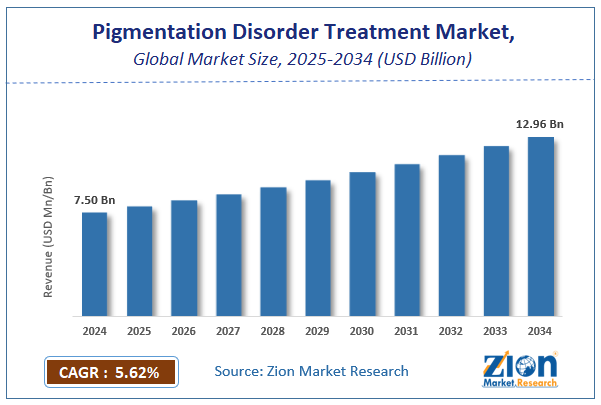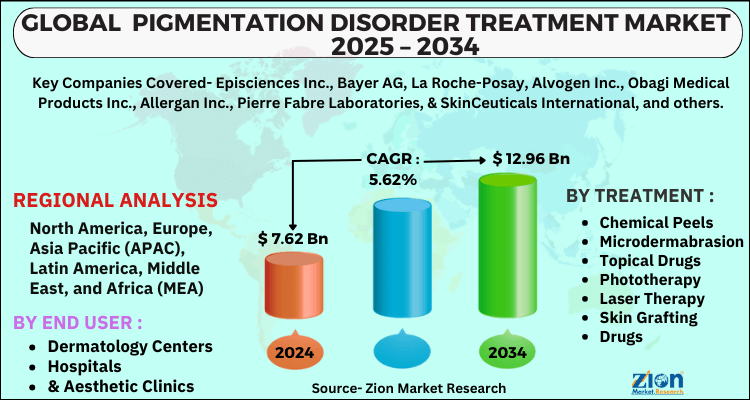Global Pigmentation Disorder Treatment Market Size, Share, Growth Analysis Report - Forecast 2034

Pigmentation Disorder Treatment Market By Treatment (Chemical Peels, Microdermabrasion, Topical Drugs, Phototherapy, Laser Therapy, Skin Grafting, Drugs, & Others), By End User (Dermatology Centers, Hospitals, & Aesthetic Clinics), and By Region: Global and Regional Industry Overview, Market Intelligence, Comprehensive Analysis, Historical Data, and Forecasts 2025 - 2034
| Market Size in 2024 | Market Forecast in 2034 | CAGR (in %) | Base Year |
|---|---|---|---|
| USD 7.50 Billion | USD 12.96 Billion | 5.62% | 2024 |
Pigmentation Disorder Treatment Market Size
The global pigmentation disorder treatment market size was worth around USD 7.50 Billion in 2024 and is predicted to grow to around USD 12.96 Billion by 2034 with a compound annual growth rate (CAGR) of roughly 5.62% between 2025 and 2034.
The report analyzes the global pigmentation disorder treatment market's drivers, restraints/challenges, and the effect they have on the demands during the projection period. In addition, the report explores emerging opportunities in the pigmentation disorder treatment industry.
This report discusses market research on the pigmentation disorder treatment market, its market growth factors, and its challenges. The report also talks about the opportunities available to stakeholders, researchers, and potential investors for the pigmentation disorder treatment market, discussing the recent changes due to the pandemic.
Pigmentation Disorder Treatment Market: Overview
Pigmentation is a skin condition caused by high quantities of melanin, a pigment produced by melanocytes. The amino acid tyrosine is oxidized, resulting in the formation of melanin. Melanin is carried by keratinocytes and, while it is innocuous, it dulls the skin. It mostly affects the face, although it could also impact various regions of the body. Whenever melanocytes are harmed, the body's melanin synthesis varies. The skin blackens or lightens as a result of this condition. The formation of melanin causes the skin to darken, while reduced synthesis of melanin causes the skin to lighten.
Key Insights
- As per the analysis shared by our research analyst, the global pigmentation disorder treatment market is estimated to grow annually at a CAGR of around 5.62% over the forecast period (2025-2034).
- Regarding revenue, the global pigmentation disorder treatment market size was valued at around USD 7.50 Billion in 2024 and is projected to reach USD 12.96 Billion by 2034.
- The pigmentation disorder treatment market is projected to grow at a significant rate due to increasing demand for aesthetic treatments, rising prevalence of skin disorders, advancements in dermatological therapies, and growing awareness of skincare solutions.
- Based on Treatment, the Chemical Peels segment is expected to lead the global market.
- On the basis of End User, the Dermatology Centers segment is growing at a high rate and will continue to dominate the global market.
- Based on region, North America is predicted to dominate the global market during the forecast period.
Pigmentation Disorder Treatment Market: Growth Drivers
Increase in skin pigmentation disorders to drive the market growth
Dark-skinned individuals have a high frequency of pigmentary diseases. Pigmentary dermatomes are also the second and fifth most frequent dermatomes among Blacks and Hispanics, correspondingly. Increased sun exposure, rise in global warming, and the increased incidence of harmful sun rays due to environmental degradation are contributing factors to rise in pigmentary disorders. As a result, the global pigmentation disorder treatment market is predicted to grow due to the increased frequency of pigmentation disorders.
Pigmentation Disorder Treatment Market: Restraints
Lack of reimbursement policies for pigmentation treatment to affect the market negatively
In general case, insurance, or reimbursement is provided for medical expenses and treatments. But in the case of pigmentation disorders and its treatments, it is not covered under any policy. Only individuals from the higher economic segment of the society can afford such procedures, without any support of insurance. As a result, this causes a restraint for the growth of global pigmentation disorder treatment market.
Pigmentation Disorder Treatment Market: Opportunities
Improvements in tissue engineering to open avenues for new procedures
Developments such as artificial skin drafts and engineered skin have evolved in the market. This not only helps in pigmentation disorders but also helps in wound healing. These skins are made out of artificial and natural materials, such as xenogenic, synthetic, allograft or autologous sources. This opens up new avenues for pigmentation treatments, given more research is conducted. This provides new opportunities for the global market.
Pigmentation Disorder Treatment Market: Challenges
High cost of cosmetic treatments poses a challenge for the market
Though tremendous development in the pigmentation treatment market boosted the market opportunities, the cost of these procedures are expensive. The only affordable treatment for the masses is OTC or tropical medications. But the efficiency of these treatments is very less in comparison to other alternatives. High prices pose a threat to the global pigmentation disorder treatment market growth.
Pigmentation Disorder Treatment Market: Segmentation Analysis
The market is divided on the basis of treatment, end-user, and region.
By treatment, the market is segregated into chemical peels, microdermabrasion, topical drugs, phototherapy, laser therapy, skin grafting, drugs, & others. Due to the better clinical studies in individuals with pigmentation disorders, the topical therapy category dominates the overall market. Azelaic acid, L-ascorbic acid, hydroquinone, and other topical medicines are the most commonly recommended worldwide. Topical therapy involves administering lotions, serums, creams, and ointments to the skin, which are prepared with various active components to treat specific pigmentation problems.
The market, by end user, is classified as dermatology centers, hospitals, & aesthetic clinics. In the end user segment, inclination towards aesthetic procedures is expected to increase the market of aesthetic or cosmetic institutions. On the other hand, due to affordability, people are also expected to opt for OTC medications for home treatments.
Pigmentation Disorder Treatment Market: Report Scope
| Report Attributes | Report Details |
|---|---|
| Report Name | Pigmentation Disorder Treatment Market |
| Market Size in 2024 | USD 7.50 Billion |
| Market Forecast in 2034 | USD 12.96 Billion |
| Growth Rate | CAGR of 5.62% |
| Number of Pages | 160 |
| Key Companies Covered | Episciences Inc., Bayer AG, La Roche-Posay, Alvogen Inc., Obagi Medical Products Inc., Allergan Inc., Pierre Fabre Laboratories, & SkinCeuticals International, and others. |
| Segments Covered | By Treatment, By End User, and By Region |
| Regions Covered | North America, Europe, Asia Pacific (APAC), Latin America, The Middle East and Africa (MEA) |
| Base Year | 2024 |
| Historical Year | 2020 to 2023 |
| Forecast Year | 2025 - 2034 |
| Customization Scope | Avail customized purchase options to meet your exact research needs. Request For Customization |
Pigmentation Disorder Treatment Market: Regional Analysis
Because of the increased prevalence of pigmentation issues, North America leads the global pigmentation disorder treatment market. In North America, there are well established medical structure and large market companies that provide efficient treatment choices for individuals with post-inflammatory hyperpigmentation.
Given the cultural preference for spotless and clear skin, Asian countries such as South Korea, China, Japan, and others, have an established market for pigmentation disorder treatment. Though given the prominence of several existing companies, the competition is tough in these regions.
Recent Developments
- In 2019, a brand from Singapore named Dermatix, launched Dermatic Acne Star, that helps reduce post-acne skin pigmentation spots. It is very beneficial in treatment of dark spots and hyperpigmentation that is very common among individuals with acne. The product was also in affordable ranges and consisted of Vitamin B3, hyaluronic acid, and snail slime extract.
- In 2020, dermatological treatment pathways were boosted due to acquisition of Dermira by Eli Lilly, increasing the market of pigmentation disorder treatments in North America.
Pigmentation Disorder Treatment Market: Competitive Analysis
The report provides a company market share analysis to give a broader overview of the key market players. In addition, the report also covers key strategic developments of the market, including acquisitions & mergers, new product launches, agreements, partnerships, collaborations & joint ventures, research & development, and regional expansion of major participants involved in the pigmentation disorder treatment market on a global and regional basis.
The global pigmentation disorder treatment market is dominated by players like:
- Episciences Inc.
- Bayer AG
- La Roche-Posay
- Alvogen Inc.
- Obagi Medical Products Inc.
- Allergan Inc.
- Pierre Fabre Laboratories
- & SkinCeuticals International
The global pigmentation disorder treatment market is segmented as follows;
By Treatment
- Chemical Peels
- Microdermabrasion
- Topical Drugs
- Phototherapy
- Laser Therapy
- Skin Grafting
- Drugs
- & Others
By End User
- Dermatology Centers
- Hospitals
- & Aesthetic Clinics
By Region
- North America
- The U.S.
- Canada
- Mexico
- Europe
- France
- The UK
- Spain
- Germany
- Italy
- Rest of Europe
- Asia Pacific
- China
- Japan
- India
- Australia
- South Korea
- Rest of Asia Pacific
- The Middle East & Africa
- Saudi Arabia
- UAE
- Egypt
- Kuwait
- South Africa
- Rest of the Middle East & Africa
- Latin America
- Brazil
- Argentina
- Rest of Latin America
Table Of Content
Methodology
FrequentlyAsked Questions
The global pigmentation disorder treatment market is expected to grow due to rising prevalence of skin conditions like vitiligo and melasma, increasing aesthetic consciousness, advancements in laser and topical therapies, and growing disposable incomes in emerging economies.
According to a study, the global pigmentation disorder treatment market size was worth around USD 7.50 Billion in 2024 and is expected to reach USD 12.96 Billion by 2034.
The global pigmentation disorder treatment market is expected to grow at a CAGR of 5.62% during the forecast period.
North America is expected to dominate the pigmentation disorder treatment market over the forecast period.
Leading players in the global pigmentation disorder treatment market include Episciences Inc., Bayer AG, La Roche-Posay, Alvogen Inc., Obagi Medical Products Inc., Allergan Inc., Pierre Fabre Laboratories, & SkinCeuticals International, among others.
The report explores crucial aspects of the pigmentation disorder treatment market, including a detailed discussion of existing growth factors and restraints, while also examining future growth opportunities and challenges that impact the market.
RelatedNews
HappyClients
Zion Market Research
Tel: +1 (302) 444-0166
USA/Canada Toll Free No.+1 (855) 465-4651
3rd Floor,
Mrunal Paradise, Opp Maharaja Hotel,
Pimple Gurav, Pune 411061,
Maharashtra, India
Phone No +91 7768 006 007, +91 7768 006 008
US OFFICE NO +1 (302) 444-0166
US/CAN TOLL FREE +1 (855) 465-4651
Email: sales@zionmarketresearch.com
We have secured system to process your transaction.
Our support available to help you 24 hours a day, five days a week.
Monday - Friday: 9AM - 6PM
Saturday - Sunday: Closed






